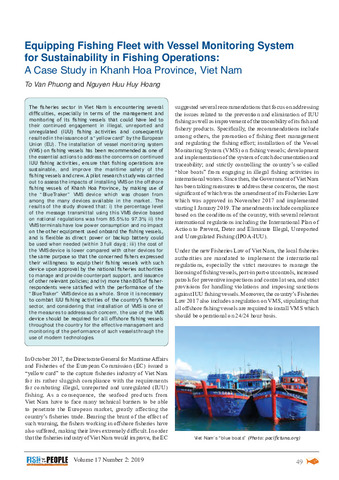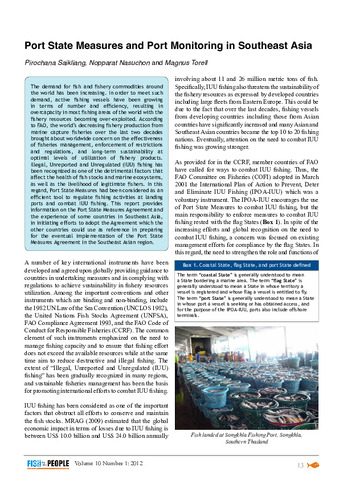Monitoring and identification of harmful algal blooms in Southeast Asia to support SDG 14.1
Share
抄録
One of the targets of SDG 14 on conservation and sustainable use of oceans, seas and marine resources for sustainable development adopted in September 2015, indicates that (SDG 14.1): By 2025, ‘marine pollution of all kinds in particular from land-based activities, including marine debris and nutrient pollution, shall have been prevented and significantly reduced.’ One of the UN indicators for achieving the said target is the ‘index of coastal eutrophication.’ By definition, ‘eutrophication is the enrichment of water as a result of an increase in nutrients, especially nitrogen and/or phosphorus, causing an accelerated growth of algae and higher forms of plant life, which can have negative impact on the marine and coastal environment.’ The Singapore-based SEAFDEC Marine Fisheries Research Department (MFRD) has embarked on a Japanese Trust Fund Project on ‘Chemicals and Drug Residues in Fish and Fish Products in Southeast Asia – Biotoxins (ASP, AZA and BTX) and Harmful Algal Blooms (HABs) in the ASEAN Region’ which includes monitoring of biotoxin-producing harmful algal bloom (HAB) species, which ensures that fish and shellfish are not contaminated with these toxic algae or their toxins, and enhances regional capabilities in identifying biotoxin-producing HAB species. This is considering that in recent decades, many coastal countries in Southeast Asia have experienced an increasing trend in pollution-associated problems caused by massive blooms of harmful and toxic algae, known before as ‘red tide’ and now better known as ‘harmful algal bloom’ (HAB). The occurrence of HAB in fresh and marine waters has led to mass mortalities of wild and cultured fish and shellfish, human illnesses and to some extent, death from contaminated shellfish or fish, death of marine mammals, seabirds, and other animals, and alteration of marine habitats or trophic structure through shading, overgrowth, or adverse effects on life history stages of fish and other marine organisms, hampering the sustainability of fisheries and aquaculture.
Suggested Citation
Soon Eong, Y., & Sulit, V. T. (2017). Monitoring and identification of harmful algal blooms in Southeast Asia to support SDG 14.1. Fish for the People , 15(1), 39-46. http://hdl.handle.net/20.500.12066/1006
主題
algal blooms  ; toxic substances
; toxic substances  ; environmental monitoring
; environmental monitoring  ; eutrophication
; eutrophication  ; fishery institutions
; fishery institutions  ; marine pollution
; marine pollution  ; marine resources
; marine resources  ; mortality causes
; mortality causes  ; pollution monitoring
; pollution monitoring  ; public health
; public health  ; Red tides; resource conservation
; Red tides; resource conservation  ; resource management
; resource management  ; sustainable development
; sustainable development  ; sustainability
; sustainability  ; South East Asia
; South East Asia
 ; toxic substances
; toxic substances  ; environmental monitoring
; environmental monitoring  ; eutrophication
; eutrophication  ; fishery institutions
; fishery institutions  ; marine pollution
; marine pollution  ; marine resources
; marine resources  ; mortality causes
; mortality causes  ; pollution monitoring
; pollution monitoring  ; public health
; public health  ; Red tides; resource conservation
; Red tides; resource conservation  ; resource management
; resource management  ; sustainable development
; sustainable development  ; sustainability
; sustainability  ; South East Asia
; South East Asia
Collections
Related items
Showing items related by title, author, creator and subject.
-
Monitoring Socio-economics of the ICRM Project Pathew District, Chumphon Province
Suasi, Thanyalak (Training Department, Southeast Asian Fisheries Development Center, 2007)The paper contains the results of the two socio-economic surveys of the integrated coastal resource management projects that were conducted in Pakklong Sub-District, Pathew District, Chumphon Province in Thailand. The first ... -
Equipping fishing fleet with vessel monitoring system for sustainability in fishing operations: A case study in Khanh Hoa Province, Viet Nam
Phuong, Van; Nguyen, Huu Huy Hoang (Secretariat, Southeast Asian Fisheries Development Center, 2019)The fisheries sector in Viet Nam is encountering several difficulties, especially in terms of the management and monitoring of its fishing vessels that could have led to their continued engagement in illegal, unreported ... -
Port State measures and port monitoring in Southeast Asia
Saikliang, Pairochana; Nasuchon, Nopparat; Torell, Magnus (Secretariat, Southeast Asian Fisheries Development Center, 2012)The demand for fish and fishery commodities around the world has been increasing. In order to meet such demand, active fishing vessels have been growing in terms of number and efficiency, resulting in overcapacity in most ...




